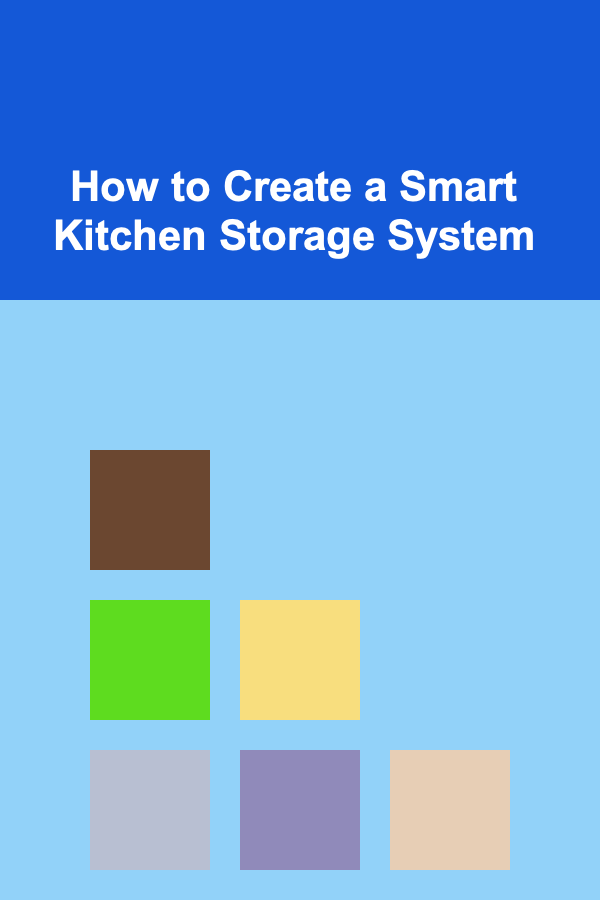
How to Create a Smart Kitchen Storage System
ebook include PDF & Audio bundle (Micro Guide)
$12.99$7.99
Limited Time Offer! Order within the next:

The kitchen is often the heart of the home. It's where meals are prepared, family conversations take place, and friends gather. However, it's also one of the most cluttered areas of the house. Between pots, pans, utensils, gadgets, and ingredients, a kitchen can quickly become chaotic if it's not properly organized. This is where a smart kitchen storage system comes into play. A well-designed storage system not only saves time and energy but also enhances the efficiency and aesthetic appeal of your kitchen.
In this article, we'll dive deep into the process of creating a smart kitchen storage system. We'll explore the importance of having a well-organized kitchen, the different types of storage solutions available, and how you can strategically implement them to optimize your space.
Understanding the Importance of a Smart Kitchen Storage System
A well-organized kitchen is more than just aesthetically pleasing. It plays a crucial role in improving your daily kitchen experience, increasing productivity, and even boosting your mood. Imagine how much smoother cooking would be if you could find everything you need without having to dig through cluttered drawers or shelves. A smart storage system helps you achieve that.
Here are some reasons why having a smart kitchen storage system is essential:
- Efficiency: A clutter-free kitchen makes it easier to find and access tools, utensils, and ingredients. This leads to faster meal preparation and cleaner workspaces.
- Maximized Space: Kitchens, especially smaller ones, often lack sufficient space. A smart storage system helps you use every inch efficiently, whether it's through vertical storage, pull-out shelves, or hidden compartments.
- Improved Safety: Proper storage reduces the risk of accidents by keeping sharp objects and heavy items stored safely. For example, knives should be placed securely, and heavy pots should be stored lower to prevent injury.
- Long-Term Durability: Proper storage helps keep your kitchenware and appliances in good condition, extending their lifespan.
- Visual Appeal: A neat kitchen is visually appealing. A smart storage system helps create a cohesive, organized, and clean environment.
Now that we understand the importance of a smart kitchen storage system, let's explore the various elements that make one successful.
Assess Your Kitchen Space
Before implementing any storage solutions, the first step is to assess your kitchen space. Every kitchen is unique, with different layouts, sizes, and types of storage. Whether you have a spacious kitchen with a large pantry or a compact one with limited cabinet space, knowing the dimensions and available areas is key to planning.
1.1 Understand Your Kitchen Layout
There are several kitchen layouts, including galley kitchens, L-shaped kitchens, U-shaped kitchens, and open-concept kitchens. The layout will determine how you can best utilize available space for storage.
- Galley Kitchens: These kitchens typically have two parallel walls with limited space. Maximizing vertical storage through shelves, hanging racks, and overhead cabinets is essential in this layout.
- L-Shaped Kitchens: In an L-shaped kitchen, one corner is typically available for storage. Corner cabinets with pull-out racks or lazy Susans can provide much-needed access to that underutilized space.
- U-Shaped Kitchens: U-shaped kitchens offer three walls for storage. You can take advantage of this by using deep cabinets, pull-out pantries, and drawer dividers.
- Open-Concept Kitchens: Open kitchens allow you to incorporate storage solutions that double as design features, such as open shelving or stylish storage islands.
1.2 Assess Your Storage Needs
The next step is to assess your storage needs. What do you store most often in your kitchen? Do you have an abundance of pots and pans? Are you an avid baker with lots of baking tools? Do you need space for various spices, canned goods, and pantry items?
This assessment will help you prioritize which items need the most attention when it comes to storage. Grouping items based on frequency of use and category (e.g., cookware, utensils, dry goods, etc.) will guide your decisions.
Categorize Your Kitchen Items
Once you understand your kitchen space and layout, it's time to categorize your kitchen items. Grouping them by type will help determine how and where to store them.
2.1 Cooking Essentials
Items such as pots, pans, and kitchen tools should be stored in easily accessible areas. Here are some tips:
- Heavy Pots and Pans: Store these in lower cabinets to avoid straining your back when retrieving them. Use pull-out shelves or drawers for easy access.
- Small Kitchen Tools: Consider using drawer dividers or utensil trays to keep small tools organized and easily accessible.
- Knives: A knife block or magnetic strip is an excellent solution for keeping knives safe and readily available.
2.2 Dry Goods and Pantry Items
Dry goods, such as grains, pasta, spices, and canned items, need to be organized efficiently to avoid confusion and spoilage. Consider the following:
- Pantry Organization: Use clear containers for grains, pasta, and other dry goods to keep them fresh and visible. Group similar items together in the pantry, such as canned goods, snacks, and baking supplies.
- Spices: A spice rack or drawer organizer can help prevent spices from getting lost in the back of the cabinet. Magnetic spice jars or spice racks on the wall are space-efficient options.
- Canned Goods: Use a can rack to easily organize and access canned items. A tiered rack allows you to see all labels and choose items with ease.
2.3 Appliances
Large appliances such as mixers, blenders, and food processors often take up valuable counter space. It's crucial to store them in a way that maximizes both function and space.
- Cabinet Storage: Store appliances in cabinets or deep drawers when not in use. Pull-out shelves or pull-down racks can make accessing these items much easier.
- Counter Storage: If you're limited on storage, designate a section of the counter for appliances that are frequently used. A stylish appliance garage can hide appliances when not in use while keeping them accessible.
2.4 Dishware and Glassware
Dishes, bowls, cups, and glassware should be stored in cabinets close to the sink for easy access. Consider the following:
- Stacking: Stack dishes, bowls, and cups to make the most of your cabinet space. Use shelf dividers to keep things organized.
- Pull-out Drawers: For easier access, consider using pull-out drawers for storing plates and bowls, especially in lower cabinets.
- Open Shelving: If you prefer to display your dishware, open shelves are a great solution. Displaying mugs, glasses, and plates creates a visually appealing storage solution.
Invest in Smart Storage Solutions
Once you've categorized your items, it's time to invest in smart storage solutions that optimize space and improve accessibility.
3.1 Pull-Out Shelves and Drawers
Pull-out shelves and drawers are excellent storage solutions for kitchen items like pots, pans, and utensils. These allow you to access the back of deep cabinets with ease. Drawers are ideal for storing smaller items like kitchen tools and cutlery. They help keep everything organized and visible, eliminating the need to dig through piles of items.
3.2 Lazy Susans and Turntables
Lazy Susans and turntables are ideal for organizing kitchen items in corner cabinets or deep shelves. These rotating organizers allow you to access all items with a simple turn, making it easy to find what you're looking for. They are perfect for storing spices, condiments, oils, or even canned goods.
3.3 Vertical Storage
In smaller kitchens, vertical storage is key. Shelves, hanging racks, and wall-mounted organizers maximize vertical space, allowing you to store items without taking up valuable floor space.
- Wall-Mounted Shelves: These can be used to store cookbooks, jars, or decorative items. Floating shelves create an open and airy feel while providing storage.
- Hanging Racks: For tools like pots, pans, and utensils, a hanging rack can keep them accessible and free up drawer space.
- Pegboards: A pegboard is an excellent solution for hanging kitchen tools, such as measuring spoons, cups, and even cutting boards. You can customize it to fit your needs.
3.4 Drawer Organizers
Drawer organizers help keep smaller items like silverware, utensils, and kitchen gadgets neat and accessible. Choose adjustable dividers that allow for flexibility in organizing your kitchen drawers.
3.5 Built-In Pantry Systems
A well-designed pantry system can make all the difference in a kitchen. Built-in pantry systems with pull-out shelves, tiered racks, and clear bins maximize storage and organization. You can also install a vertical pull-out pantry for narrow spaces to store dry goods and canned items efficiently.
Optimize Kitchen Zones
Creating kitchen zones is another smart way to optimize your kitchen storage. By grouping similar tasks and items together, you can reduce movement and improve workflow in the kitchen.
4.1 Cooking Zone
The cooking zone should include your stove, oven, pots, pans, and utensils. Everything you need for meal preparation should be within arm's reach. Install drawers and pull-out shelves for easy access to cookware and utensils.
4.2 Cleaning Zone
The cleaning zone should be close to the sink and dishwasher. Store dish soap, sponges, and cleaning supplies in this area. A pull-out trash bin and recycling station can help keep this zone tidy and organized.
4.3 Prep Zone
The prep zone is where all the cutting, chopping, and mixing takes place. Keep cutting boards, knives, and mixing bowls in this area. Drawer dividers or pull-out shelves can store prep tools for quick and easy access.
4.4 Storage Zone
The storage zone is where dry goods, canned goods, and pantry items should be kept. This area should be well-organized with clear bins, spice racks, and labeled shelves.
Maintain Your Kitchen Storage System
A smart kitchen storage system requires regular maintenance to keep it functional and organized. Periodically reassess your storage solutions and reorganize as necessary. Clean out expired pantry items, declutter drawers, and ensure that everything has a designated spot.
5.1 Declutter Regularly
As you use your kitchen, it's easy for items to accumulate. Regularly go through your kitchen and donate or discard items you no longer use. Keeping your storage solutions free of unnecessary items ensures that your kitchen remains organized and functional.
5.2 Keep Items Accessible
Consider rotating pantry items to keep older items in the front, making them easier to use. Store frequently used items in accessible areas and less-used items in deeper cabinets or drawers.
5.3 Stay Consistent
Once you've established a system, stick to it. Always return items to their designated storage areas to maintain order. Encourage everyone in the household to follow the same organizational methods for consistency.
Conclusion
Creating a smart kitchen storage system requires a mix of careful planning, smart storage solutions, and consistent maintenance. By understanding your space, categorizing your kitchen items, investing in efficient storage solutions, and optimizing kitchen zones, you can create a kitchen that is both functional and aesthetically pleasing. With a little effort and a well-organized approach, you'll transform your kitchen into a space that enhances your cooking experience and keeps your home running smoothly.
Reading More From Our Other Websites
- [Personal Care Tips 101] How to Make Your Own DIY Hair Oil at Home
- [Personal Finance Management 101] How to Track Your Investments: From Spreadsheet to Portfolio Management Software
- [Home Maintenance 101] How to Inspect and Maintain Your Home's Plumbing System
- [Home Cleaning 101] How to Clean an Oven: Easy Ways to Remove Grease and Grime
- [Paragliding Tip 101] Common Mistakes in Thermal Soaring and How to Avoid Them
- [Home Budget 101] How to Reduce Your Monthly Mortgage Payment Without Refinancing
- [Home Storage Solution 101] How to Store and Organize Your Home Workout Equipment
- [Home Pet Care 101] How to Keep Your Indoor Cat Entertained: Ultimate Playtime Guide
- [Home Renovating 101] How to Find the Best Home Renovation Ideas on a Budget
- [Organization Tip 101] How to Set Up a Family Recipe Binder for Easy Cooking

How to Set Up a Recipe Book Exchange Program
Read More
How to Soundproof Your Home Theatre Room
Read More
How to Upgrade Your Home's Security After a Break-in
Read More
Choosing the Right Oven Rack for Optimal Baking
Read More
How to Pass the Actuarial Exams: A Comprehensive Guide
Read More
How to Build a Chess Opening Repertoire as Black
Read MoreOther Products

How to Set Up a Recipe Book Exchange Program
Read More
How to Soundproof Your Home Theatre Room
Read More
How to Upgrade Your Home's Security After a Break-in
Read More
Choosing the Right Oven Rack for Optimal Baking
Read More
How to Pass the Actuarial Exams: A Comprehensive Guide
Read More